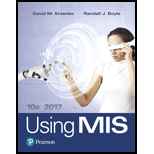
Explanation of Solution
Outsourcing:
In this process an organization hires another organization to perform an activity which is originally the internal activity of the company which is hiring. It is performed to gain expertise, to save costs, to free management time which will let the organization to expertise in the areas where they want to outsource.
Drucker’s statement:
- As per Drucker’s statement, “your back room is someone else’s front room”, an organization’s back room can form a front room for some other organization.
- For example, like many companies, running the cafeterias is considered as a “back room” because it is not an important function for business success.
- It is same in Google’s case, the cafeteria area is the back room for Google but it has hired another company which is specialized in food services.
- The cafeteria business is the front room for the second company with which Google has started its contractual agreement.
- Now, this has helped Google to pay complete attention towards mobile computing, search, and advertising-revenue growth.
Management advantages:
Outsourcing is the one of the best ways to gain expertise in a quicker way.
- Many organizations may not have sufficient resources to produce some important product or to complete some internal activity, but with the help of outsourcing and strategic partnerships it can make products and can even complete all the internal activities with the help of experts.
- Outsourcing also helps avoid management problems.
Cost advantages:
Cost reduction is one of the advantages of outsourcing. Organizations can have part-time services with the help of outsourcing.
- Outsourcing can also be used in gaining cost reduction benefits by using a method in which 25 organizations outsource to the same payroll vendor and then the vendor can make all the necessary changes at once.
- Thus, the cost that is to be paid to vendor by 25 organizations individually decreases if they use the outsourcing technique.
Outsourcing risk:
Outsourcing can also help in decreasing the risk.
- For example, it can help reduce financial risk, as it is seen in typical outsourcing contract, the outsource vendor will agree to a fixed price for the services.
- Organizations need not to pay a bulk of amount until the completion of the work. Secondly it also reduces the risk by ensuring a certain standard of quality.
Difference between IaaS, PaaS, and SaaS:
| Infrastructure-as-a-service (IaaS) | Platform-as-a-service(PaaS) | Software-as-a-service(SaaS) |
|
IaaS is the simplest of all the three cloud models because it is the same for every vendor. |
PaaS is the hardest one of all the three cloud models. In this, the basic idea of IaaS, the tools needed to develop and deploy applications are provided. | SaaS is the model where the software is hosted by the third party but can be accessed over the web and is different than the earlier ones where the organization buys and installs software on a machine or server manually. |
| This includes a third party which provides highly automated and scalable IT infrastructure and charges for the resources that are used. | It should provide the developer with everything that is needed to build and deploy an application without provisioning the underlying infrastructure themselves. | It is more relevant for few applications, like email or customer relationship management software... |
Want to see the full answer?
Check out a sample textbook solution
Chapter 11 Solutions
Using MIS (10th Edition)
- "Do not use AI tools. Solve the problem by hand on paper only and upload a photo of your handwritten solution."arrow_forward"Do not use AI tools. Solve the problem by hand on paper only and upload a photo of your handwritten solution."arrow_forward"Do not use AI tools. Solve the problem by hand on paper only and upload a photo of your handwritten solution."arrow_forward
- "Do not use AI tools. Solve the problem by hand on paper only and upload a photo of your handwritten solution."arrow_forwardSolve this "Do not use AI tools. Solve the problem by hand on paper only and upload a photo of your handwritten solution."arrow_forward"Do not use AI tools. Solve the problem by hand on paper only and upload a photo of your handwritten solution."arrow_forward
- "Do not use AI tools. Solve the problem by hand on paper only and upload a photo of your handwritten solution."arrow_forwardSpecifications: Part-1Part-1: DescriptionIn this part of the lab you will build a single operation ALU. This ALU will implement a bitwise left rotation. Forthis lab assignment you are not allowed to use Digital's Arithmetic components.IF YOU ARE FOUND USING THEM, YOU WILL RECEIVE A ZERO FOR LAB2!The ALU you will be implementing consists of two 4-bit inputs (named inA and inB) and one 4-bit output (named out). Your ALU must rotate the bits in inA by the amount given by inB (i.e. 0-15).Part-1: User InterfaceYou are provided an interface file lab2_part1.dig; start Part-1 from this file.NOTE: You are not permitted to edit the content inside the dotted lines rectangle. Part-1: ExampleIn the figure above, the input values that we have selected to test are inA = {inA_3, inA_2, inA_1, inA_0} = {0, 1, 0,0} and inB = {inB_3, inB_2, inB_1, inB_0} = {0, 0, 1, 0}. Therefore, we must rotate the bus 0100 bitwise left by00102, or 2 in base 10, to get {0, 0, 0, 1}. Please note that a rotation left is…arrow_forwardSolve this "Do not use AI tools. Solve the problem by hand on paper only and upload a photo of your handwritten solution."arrow_forward
- Solve this "Do not use AI tools. Solve the problem by hand on paper only and upload a photo of your handwritten solution."arrow_forward"Do not use AI tools. Solve the problem by hand on paper only and upload a photo of your handwritten solution."arrow_forwardSolve this "Do not use AI tools. Solve the problem by hand on paper only and upload a photo of your handwritten solution."arrow_forward
 Principles of Information Systems (MindTap Course...Computer ScienceISBN:9781285867168Author:Ralph Stair, George ReynoldsPublisher:Cengage Learning
Principles of Information Systems (MindTap Course...Computer ScienceISBN:9781285867168Author:Ralph Stair, George ReynoldsPublisher:Cengage Learning Principles of Information Systems (MindTap Course...Computer ScienceISBN:9781305971776Author:Ralph Stair, George ReynoldsPublisher:Cengage Learning
Principles of Information Systems (MindTap Course...Computer ScienceISBN:9781305971776Author:Ralph Stair, George ReynoldsPublisher:Cengage Learning Fundamentals of Information SystemsComputer ScienceISBN:9781337097536Author:Ralph Stair, George ReynoldsPublisher:Cengage Learning
Fundamentals of Information SystemsComputer ScienceISBN:9781337097536Author:Ralph Stair, George ReynoldsPublisher:Cengage Learning Information Technology Project ManagementComputer ScienceISBN:9781337101356Author:Kathy SchwalbePublisher:Cengage Learning
Information Technology Project ManagementComputer ScienceISBN:9781337101356Author:Kathy SchwalbePublisher:Cengage Learning Fundamentals of Information SystemsComputer ScienceISBN:9781305082168Author:Ralph Stair, George ReynoldsPublisher:Cengage Learning
Fundamentals of Information SystemsComputer ScienceISBN:9781305082168Author:Ralph Stair, George ReynoldsPublisher:Cengage Learning





